Are you ready to take your creativity to new heights? Mind mapping is the key to unlocking your untapped potential and unleashing a wave of innovative ideas. In this comprehensive guide, we’ll delve into the world of mind mapping, exploring its techniques, advantages, and practical applications. Let’s chart a course to creative brilliance together.
Understanding Mind Mapping

The Basics
Mind mapping is more than just drawing circles and lines; it’s a dynamic technique that mirrors the way our minds naturally organize information. By visually representing thoughts and concepts, you can create a roadmap for your ideas.
Origins and Evolution
Delving into the origins of mind mapping, we find its roots in the works of Tony Buzan. Over the years, it has evolved from a simple note-taking method to a powerful tool for brainstorming and problem-solving.
Benefits of Mind Mapping

Improved Memory
Mind mapping engages both hemispheres of the brain, enhancing memory retention. Through visual associations, information becomes more memorable and easier to recall.
Enhanced Problem-Solving
Experience a new level of problem-solving prowess by breaking down complex issues into manageable components. Mind maps provide a clear structure for analyzing and solving problems.
How to Create a Mind Map

Step-by-Step Guide
Let’s dive into the practical aspects. Creating a mind map involves several steps, from selecting a central idea to branching out with keywords and connecting concepts. Follow our step-by-step guide for a seamless mind mapping experience.
Recommended Tools
Discover a variety of tools that can elevate your mind mapping journey. From traditional pen and paper to digital platforms like MindMeister and XMind, choose the tool that best suits your preferences.
1. MindMeister :

A popular digital platform that provides collaborative mind mapping features, allowing multiple users to work on the same mind map in real time.
2. XMind :

A versatile digital tool that offers a range of features for mind mapping, including various templates and customization options.
Choose the tool that aligns with your preferences and enhances your mind mapping experience.
Creative Mapping Examples for Students
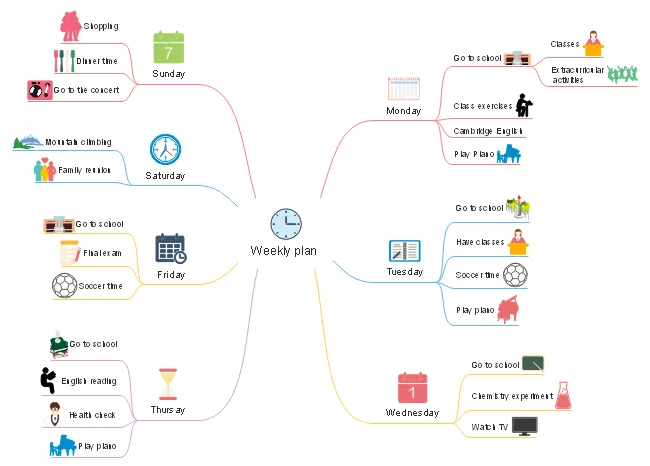
Mind maps are an excellent tool for students to organize information, simplify complex concepts, and improve memory retention. In this article, we will introduce several mind map examples for students that cover different subjects and study scenarios. These mind maps for students not only provide a visual learning experience but also pave the way for better understanding.
1.1 Notetaking
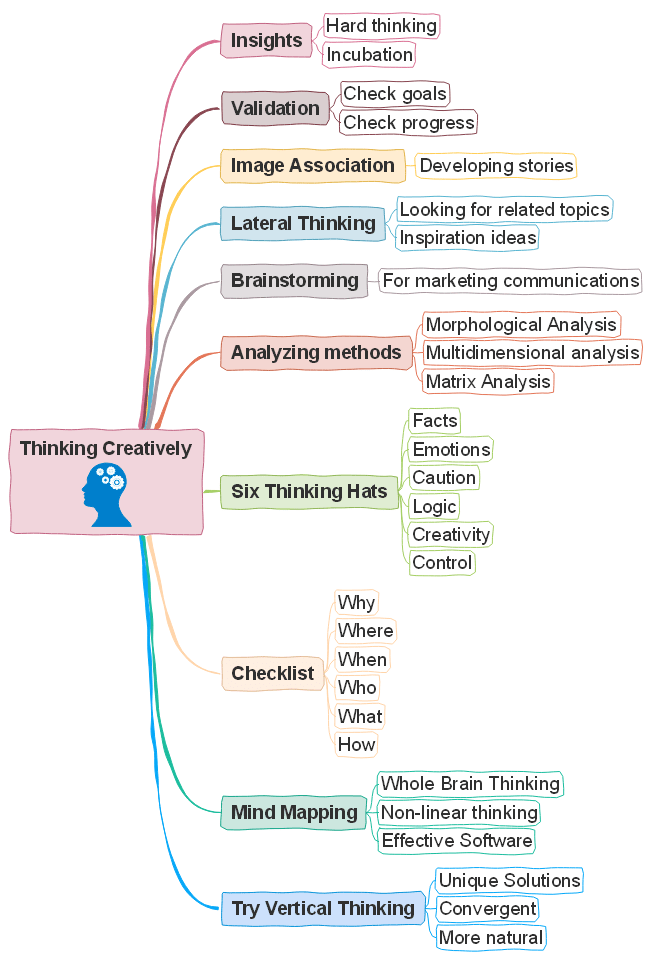
Since notes are meant to channel the progression of a research or project in crucial areas, they must be close at hand and simple to decode when shared with a peer. Organizing handwritten drafts into neat mind map templates like this one above can serve the purpose well and well. Always keep a focal element when creating this sort of mind map that can anchor the jargon of data cohesively.
1.2 Learn A Language
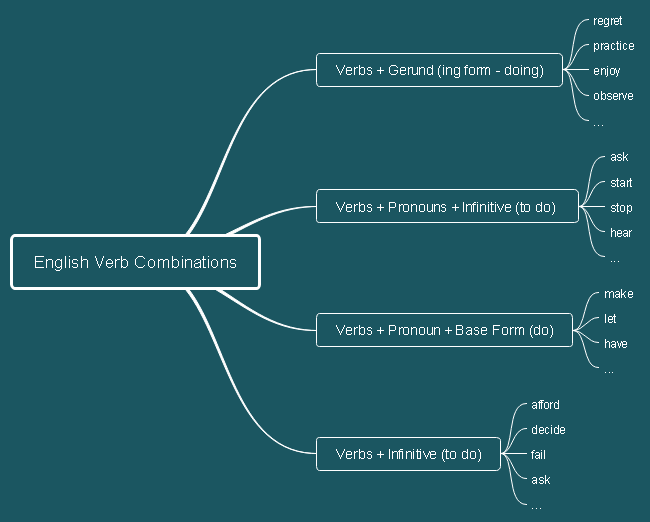
Learning a language goes through various aspects and layers of applications. Still, this program has the benefit of a generic framework with the lessons often revolving around things we already know. Therefore, learners might already have theoretical knowledge, at least a basic concept of it, and are ready for practical approaches. In this mind map template about learning English verb combinations, the key points are verbs as well, denoted by specific courses of action. So it covers both objectives of theory and practical.
1.3 Group Work
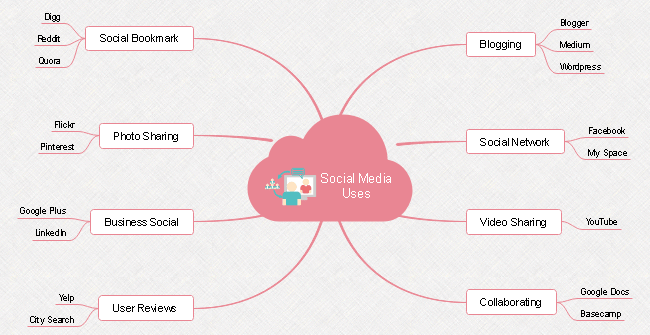
Group work is a broader spectrum than group study. It radically involves a focal matter pursued by a group but leverages individual inputs systematically. This sort of project needs a fail-proof process that makes sure that everyone’s on board; everything is on board. This crafty template about Social Media Usage can be a shining example of how it works.
1.4 Laboratory Research

Students heavily utilize mind mapping for Research and Development to create a visual semblance of specific perceptions. It is somewhat like the template above. In a simple mind map example for students of Biology, you can see that the main topic sits in the center with concise definitions of its variables laid out in a radial map. Such depictions make complex lessons memorable and impart cognitive learning.
1.5 Course Planning

A course plan that is drawn out by a School or a Teacher and how individual students practically experience it is by nature unidentical twins. Course plans that flatly address syllabuses don’t complete the picture; they need to discuss terms and categories that will influence critical projects and gradual progression. Take this Modern Art course plan template. For example, it doesn’t just list out elementary subjects covered within the course but also draws artist names and sub-genres that make up the entire bubble. The more you know beforehand, the more mentally prepared you are to get along with it.
1.6 Exam Preparation
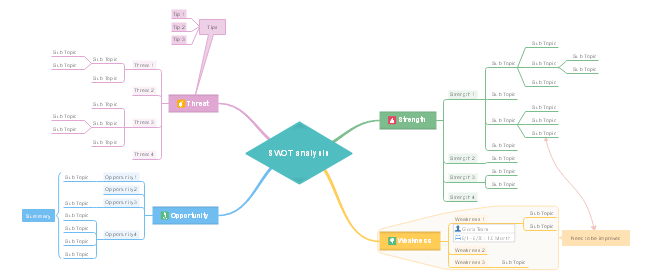
By taking out perceived notions from the mind and mirroring them in a visual illustration, students can radically improve their sense of urgency and avoid procrastination when preparing for an exam. The multivariate essentials like key lectures, notes, timeframes, criteria, available resources, or lacking areas can be brainstormed in this graphic layout so that problems are easier to address and strengths can effectually motivate. This SWOT analysis map makes up a valuable resource for the matter, streamlining different conditions and situations into Strengths, Weaknesses, Opportunities, and Threats (SWOT). It inspires students to maintain a target-based regime of studies and related activities for exam preparation, scale progress, rinse, and repeat. The conceptual use of color, structure, and a minimalist layout can simplify complex variables of prerequisites faced by students during the exam preparation phase.
1.7 Life Planner
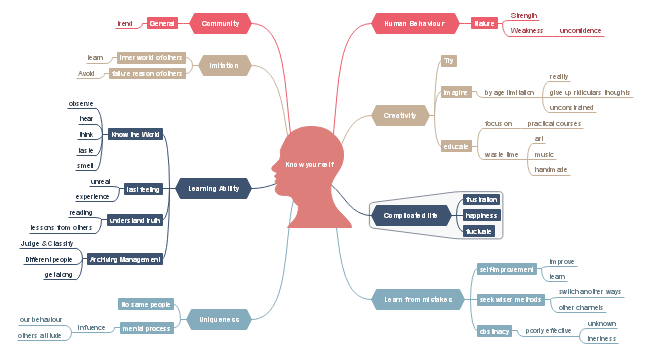
Mind Mapping is a good habit overall, which can be used, not only to organize study programs but also to build an energy-efficient life around studentship. This template is one of the simplest mind map examples for students that can do the trick just right. Due to a graphic illustration of events, situations, goals, strengths, and weaknesses, it is easier to develop a cognitive approach that works for establishing the quality of life.
1.8 Time Management
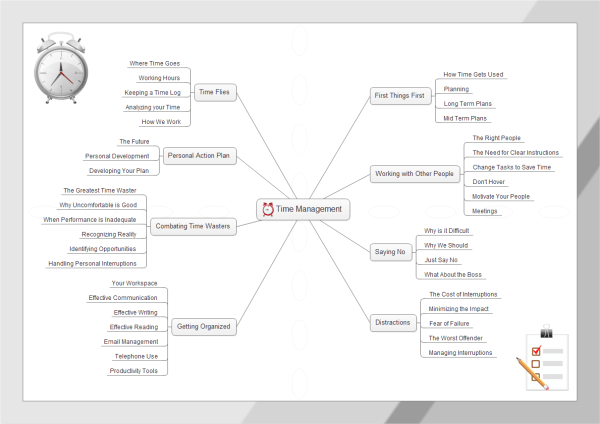
Being always on the go, living off the last minute, and nicks of time are the story of every other student’s life. It pays the most to be punctual, but chasing time needs a forgiving regime than to challenge biological clocks. This template is much more than a timetable, coming with tips, essentials, and priorities. This sort of mind map is probably thriving in stinging the creator along, giving them a sense of security that they can design their life. So not only engaging content, but it is also an exercise that may run in the subconscious of pursuers, even if they fail to keep certain things in mind.
1.9 Health
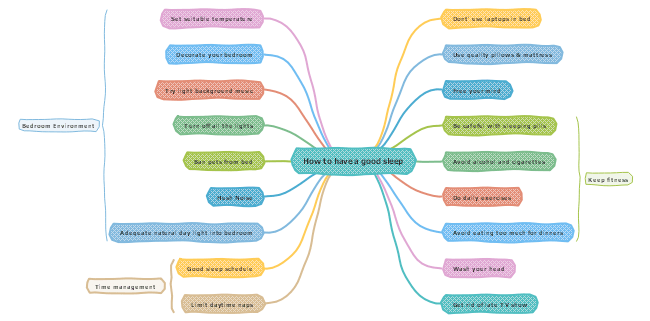
The use of simple mind map examples for students doesn’t only involve study-oriented variables. It is also about health, fitness, and overall well-being. So, keeping handy a chart of health-conscious decisions is an excellent way to start taking care. Take a cue from this template about healthy sleeping habits, something that a student vitally needs to endorse.
1.10 Trip Planner
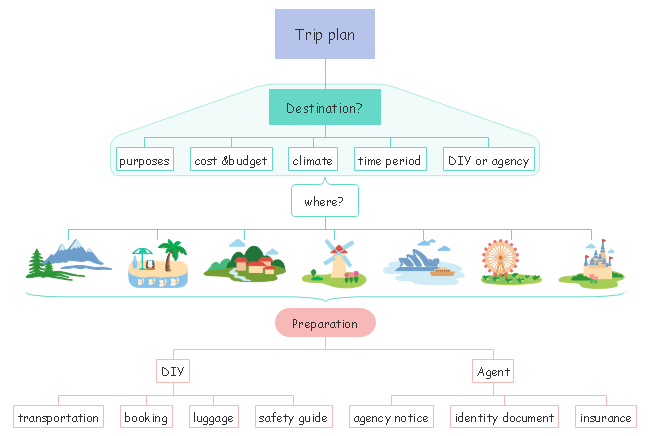
Are you going somewhere but are not entirely done with planning? Get all your friends on board with the plan. Check a simple mind map about the trip like the one above and distribute it to everyone. It puts all information under a single page with costs, budgets, agent and DIY roles, contacts, and other information related to the trip. A quick and effective solution to control your priorities as and when needed.
1.10 Organizing Room or House
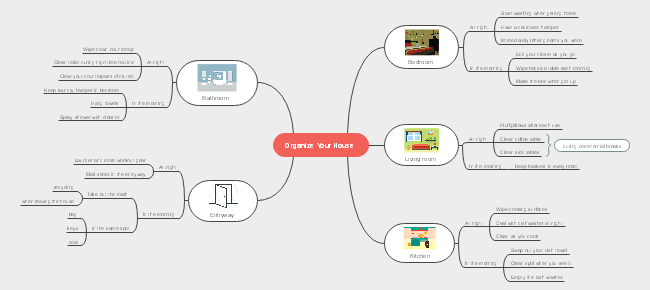
It is an absolute truth that being organized helps you stay ahead. But most of the time, in the quest to staying ahead, organizing essentials is left far behind. And this too is the story of every other student’s life. Never let the bed bugs bite you. Use pictures of your cleaned-up room and the moments of freshness that can motivate you to dig out some time out of your busy schedule to clean your house or room. You can do this!
Tips for Effective Mind Mapping

Use of Colors and Keywords
Enhance the visual appeal of your mind map by incorporating colors and emphasizing keywords. This not only makes the map more engaging but also aids in information retrieval.
Simplicity is Key
Avoid overcrowding your mind map with excessive details. Keep it simple and focused to maintain clarity and effectiveness.
Mind Mapping Tools
Digital and Traditional Options
Explore a range of mind-mapping tools, both digital and traditional. From the flexibility of digital platforms to the tactile experience of hand-drawn maps, find the method that suits your style.
Real-life Success Stories
Discover how individuals and organizations have harnessed the power of mind mapping to achieve success. Case studies provide insights into the real-world impact of this transformative technique.
Overcoming Challenges
Common Roadblocks
Address common challenges associated with mind mapping, such as information overload and organizational hurdles. Learn effective strategies for overcoming these obstacles.
Mind Mapping Advantages and Techniques
Secondary Keywords
Get deeper into the mind mapping advantage and various techniques. Uncover the nuances that make mind mapping a game-changer in both personal and professional realms.
FAQs
Q: Can anyone benefit from mind mapping?
Absolutely! Mind mapping is a versatile technique suitable for students, professionals, and creatives alike.
Q: Are there specific tools for digital mind mapping?
Yes, popular tools include MindMeister, XMind, and MindNode, each offering unique features for digital mind mapping.
Conclusion
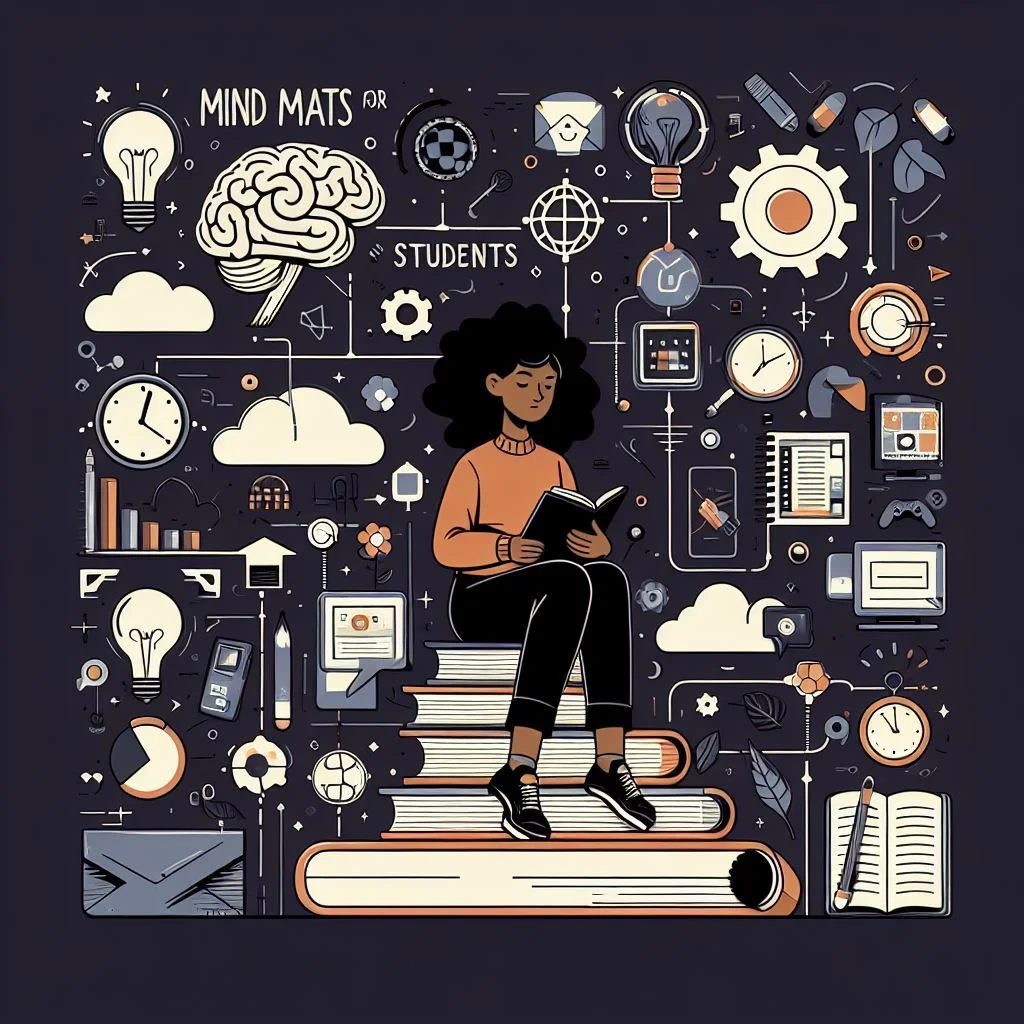
Ready to revolutionize your approach to creativity? Dive into the world of mind mapping and unlock the door to limitless possibilities. Embrace the Mind Mapping Advantage and Techniques to elevate your thinking and achieve unparalleled success.












